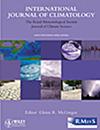摘要
基于ERA5-Land数据集降水和潜在蒸散发数据,利用标准化降水蒸散发指数(SPEI)和Run理论,对1950 - 2022年青藏高原的干旱特征进行了评价。在SPEI-1(月)、SPEI-3(季)和SPEI-12(年)多个时间尺度上的分析一致表明,近70年来青藏高原呈现明显的干燥趋势。值得注意的是,SPEI-1和SPEI-3系列分别在2000年和2001年检测到干湿过渡点,而SPEI-12系列表明2004年发生了较晚的转变。此外,SPEI值还表现出从南到北干旱状况日益严重的空间趋势。特别是,在雅鲁藏布江、恒河和印度河流域以及内高原南部地区,观察到明显的干旱压力。此外,通过交叉小波变换(XWT)和小波相干分析(WTC),确定了干旱变率与太阳黑子、厄尔尼诺Niño-Southern涛动(ENSO)、气温(TEMP)和年平均面降水量(AP)等关键气候驱动因子的关系。总体而言,青藏高原的SPEI值与ENSO和TEMP呈负相关,而与太阳黑子和AP呈正相关。该研究为青藏高原干旱动态提供了全面的时空评价,为区域水资源管理和气候变化适应规划提供了重要的参考。

Assessing drought on the Tibetan Plateau (TP) is essential for understanding the spatial characteristics of the region's hydrological regimes, as well as the trends of the evolving climate-ecological system. Based on the precipitation and the potential evapotranspiration data from the ERA5-Land dataset, this study evaluated the drought characteristics on the TP from 1950 to 2022 using the Standardised Precipitation Evapotranspiration Index (SPEI) and the Run theory. The analysis of SPEI at multiple time scales—SPEI-1 (monthly), SPEI-3 (seasonal), and SPEI-12 (annual)—consistently revealed a pronounced drying trend across the TP over the past 70 years. Notably, the wet-to-dry transition points were detected in 2000 and 2001 based on the SPEI-1 and SPEI-3 series, respectively, while the SPEI-12 series indicated a later shift occurring in 2004. In addition, the SPEI values indicated a spatial trend of increasingly severe drought conditions from south to north. Particularly, pronounced drought stress was observed in the Brahmaputra, Ganges, and Indus basins, as well as in the southern regions of the Inner Plateau. Furthermore, the relationships between drought variability and key climatic drivers—including sunspots, El Niño-Southern Oscillation (ENSO), temperature (TEMP), and annual mean areal precipitation (AP)—were identified through cross-wavelet transform (XWT) and wavelet coherence analysis (WTC). In general, the analysis showed that the SPEI values on the TP were negatively correlated to ENSO and TEMP but positively correlated to sunspots and AP. This study offers a comprehensive spatiotemporal assessment of drought dynamics across the TP, providing critical insights for regional water resource management and climate change adaptation planning.

 求助内容:
求助内容: 应助结果提醒方式:
应助结果提醒方式:


